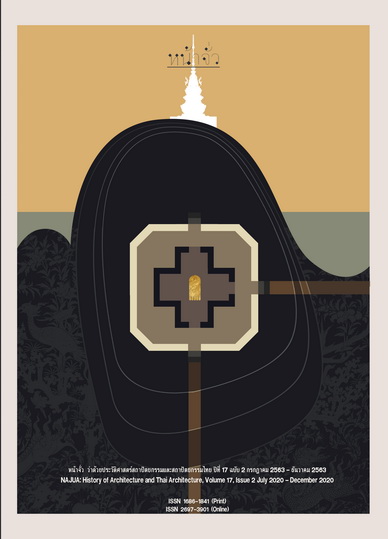Architectural Transformation of a Mondop to a Bell Shaped Chedis Raised on High Base in the Late Sukhothai Art: Evidence from Kamphaengphet Ancient City
Main Article Content
Abstract
This article examines the transformation of Mondop (the Buddha image house in Sukhothai Art in around the 13th Century A.D.) at Kamphaengpet Ancient City. The change in an architectural style is witnessed in the top part, from an application of general timber superstructure into “Bell-shaped Chedi-spired Mondop” (Mondop with a bell-shaped Chedi on the top). Such a style is considered a unique Kamphaengpet's style in the late 14th Century A.D.
The bell-shaped Chedi-spired Mondop was transformed into a bell-shaped style Chedi of Sukhothai Art in the early 15th Century A.D. A high solid base was created, instead of a hollow building enclosure, as a support for a bell-shaped Chedi, as shown at the main Chedi of Wat Sriphichitkittikalyaram Sukhothai (built in 1404 A.D.) created by an important monk from Kamphaengpet. This artistic feature can also be found at the principal Chedi of Wat Chedi Sung Sukhothai. Later in the late 15th Century A.D., this structure of high solid base to support the bell-shaped Chedi was re-created in Kamphaengpet, as evidenced at the principal Chedi of Wat Avas Yai.
This artistic evolution represents the rise of the political and religious significance of Kamphaengpet since the early 15th Century A.D, indicating that Kamphaengpet was politically used as a base to conquer Sukhothai region by Suphannaphum Dynasty of Ayutthaya.
Downloads
Article Details

This work is licensed under a Creative Commons Attribution-NonCommercial-NoDerivatives 4.0 International License.
References
Chedha Tingsanchali. čhēdī nai sinlapa Phamā - Mō̜n phatthanākān thāng dān rūpbǣp tangtǣ sinlapa sī kasēt thưng sinlapamanthalē [Stupa in Burmese-Mon Art: Evolution from Sri Ksetra to Mandalay Art]. Bangkok: Muang Boran, 2012.
Fine Art Department. chāhārưk samai sukhōthai [Sukhothai period inscription]. Bangkok: Fine Art Department, 1984.
Parkpoom U-Pool. Archaeologist, Kamphaengphet Historical Park. Interview, June 24, 2019.
Piset Chiachanphong. kamphǣng phet mō̜radok lōk thāng watthanatham [Kamphaengphet Cultural World Heritage]. Bangkok: The Teachers’ Council of Thailand Printing House, 1998.
Piset Chiachanphong. “čhu čhu yā dang phra kamlang plīk wiwēk [Hush hush, silently Lord Buddha taking a meditation].” In Ha Phra Ha Chao. 87-97. Bangkok: Matichon, 2002.
Sakchai Saisingha. “čhēdī song rakhang sakun chāng kamphǣng phet kān phasomphasān rūpbǣp sukhōthai lānnā læ ʻAyutthayā [Bell-shaped Stupas of Kamphaengphet School: An amalgam of Sukhothai, Lanna and Ayutthaya Art Styles].” Damrong Journal 18, 1 (January-June 2019): 67-88.
Sakchai Saisingha. sinlapa sukhōthai: bot wikhro̜ lakthān bōrānnakhadī čhārưk læ sinlapakam [Sukhothai Art: A view from archaeological, art and epigraphic Evidence]. Nakhon Pathom: Silpakorn University Press, 2004.
Santi Leksukhum. sinlapa sukhōthai [Sukhothai Art]. Bangkok: Muang Boran, 2006.
Santi Leksukhum and others. bōrānnasathān kap rūpbǣp sannitthān mō̜radok lōk sukhōthai sīsatnālai kamphǣngphet [Ruins and reconstructed World Heritage Sukhothai, Si Satchanalai and Kamphaeng Phet]. Bangkok: Amarin Printing and Publishing, 2008.
Santi Pakdikham andNawarat Pakdikham. prawattisāt ʻAyutthayā čhāk čhārưk: čhārưk samai ʻAyutthayā [History of Ayutthaya from epigraphy: Ayutthaya inscription]. Bangkok: Historical Soceity Under The Royal Pratronage in Princess Chakri Sirindhorn, 2018.
Subhadradis Diskul, M.C. sinlapa nai prathēt Thai [Art in Thailand: A brief history]. 13th ed. Bangkok: Matichon Pakkret Press, 2007.
Veerasak Sansaard. “khō̜mūn thī dai čhāk kān khut tǣng bōrānnasathān wat ma khō̜k mư̄ang kamphǣngphet [Data from the excavation at Makhok Temple in the ancient Kamphaeng Phet town].” Damrong Journal 15, 1 (January-June 2016): 41-66.


